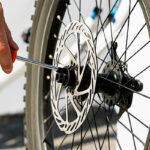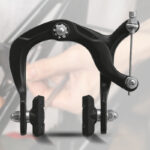Every bicycle rider knows that his or her safety and control to a great extent depends on one type of bicycle brake, whether the rider was thinking about them or not. Understanding how brakes work and the science behind their performance, cyclists can learn the best practices for maintenance and upgrades. This article takes a look at how to improve the key variables of bicycle brake performance, such as friction and modulation, as well as why improvements in brake technology are so important.
Types of Bicycle Brakes
There are various types of brakes suited for different riding conditions and styles.
- Rim Brakes: These traditional brakes work by pressing rubber pads against the wheel’s rim. Rim brakes are lightweight and straightforward, making them a popular choice for road bikes. However, they can be less effective in wet conditions, where traction between the pad and the rim decreases.
- Disc Brakes: Disc brakes have gained popularity due to their superior stopping power and consistent performance in all weather conditions. These brakes come in two main varieties.
- Mechanical disc brakes operate with cables like rim brakes but offer better modulation and stopping power.
- Hydraulic Disc Brakes: Use fluid to transfer force from the lever to the brake pads, providing precise control and smoother braking performance.
- Drum and Coaster Brakes: Positioned inside the wheel hub, these brakes require minimal maintenance and offer reliable braking. However, they are less frequently used on high-performance bikes because of their weight.
The Science of Friction in Braking
Friction allows brakes to stop a bicycle by opposing wheel motion. As the brake pads engage with the rim or rotor, the friction produced the friction produced. The effectiveness of this friction hinges on the materials used for the pads and the surfaces they interact with.
Key Factors Influencing Friction:
- Pad Material: Different materials like rubber, resin, or metallic compounds affect the braking power and durability. Resin pads offer smoother braking but may wear out faster, while metallic pads are more durable and perform better in wet conditions.
- Heat Dissipation: During prolonged braking, the heat generated can reduce friction, leading to brake fade. Quality brake systems are designed to dissipate this heat efficiently to maintain optimal performance.
Modulation and Control in Bicycle Brakes
Brake modulation is the ability to finely control the braking force applied to the wheels. Effective modulation enables riders to apply the right amount of braking power, especially during fast or technical descents. This feature is crucial to prevent wheel lockup, which can lead to skidding and loss of control.
Why Modulation Matters:
- Smooth Stops: Modulation enables smoother deceleration without sudden jerks.
- Improved Safety: Improved braking control allows riders to safely tackle difficult terrains.
Innovations in Bicycle Brake Technology
Advancements in bicycle brake technology focus on efficiency, reliability, and ease of use. Some of the latest developments include:
- Self-Adjusting Calipers: These systems automatically adjust to pad wear, reducing the need for frequent manual adjustments.
- Electronic Braking Systems: Cutting-edge technology that provides precise control and integrates seamlessly with modern bikes for enhanced performance.
Conclusion
Bicycle brake performance combines mechanical principles, material technology, and innovative design. Whether you’re a casual rider or a competitive cyclist, understanding how these elements work together can help you choose the best brakes for your needs, ensuring a safer and more controlled riding experience.
S.K. Aggarwal & Co. has integrated these advanced technologies into their Sprandom brand of bicycle brakes, delivering reliable and high-performance braking systems for all cycling enthusiasts. With commitment to quality and innovation, Sprandom brakes are engineered to meet the demands of modern riders, ensuring the highest level of safety and performance on every ride.
Read More About “Top 5 Common Bicycle Brake Problems And How to Fix Them“





